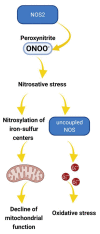Nitric-Oxide-Mediated Signaling in Podocyte Pathophysiology
- PMID: 35740870
- PMCID: PMC9221338
- DOI: 10.3390/biom12060745
Nitric-Oxide-Mediated Signaling in Podocyte Pathophysiology
Abstract
Nitric oxide (NO) is a potent signaling molecule involved in many physiological and pathophysiological processes in the kidney. NO plays a complex role in glomerular ultrafiltration, vasodilation, and inflammation. Changes in NO bioavailability in pathophysiological conditions such as hypertension or diabetes may lead to podocyte damage, proteinuria, and rapid development of chronic kidney disease (CKD). Despite the extensive data highlighting essential functions of NO in health and pathology, related signaling in glomerular cells, particularly podocytes, is understudied. Several reports indicate that NO bioavailability in glomerular cells is decreased during the development of renal pathology, while restoring NO level can be beneficial for glomerular function. At the same time, the compromised activity of nitric oxide synthase (NOS) may provoke the formation of peroxynitrite and has been linked to autoimmune diseases such as systemic lupus erythematosus. It is known that the changes in the distribution of NO sources due to shifts in NOS subunits expression or modifications of NADPH oxidases activity may be linked to or promote the development of pathology. However, there is a lack of information about the detailed mechanisms describing the production and release of NO in the glomerular cells. The interaction of NO and other reactive oxygen species in podocytes and how NO-calcium crosstalk regulates glomerular cells' function is still largely unknown. Here, we discuss recent reports describing signaling, synthesis, and known pathophysiological mechanisms mediated by the changes in NO homeostasis in the podocyte. The understanding and further investigation of these essential mechanisms in glomerular cells will facilitate the design of novel strategies to prevent or manage health conditions that cause glomerular and kidney damage.
Keywords: glomerulus; hypertension; lupus nephritis; nitric oxide synthase.
Conflict of interest statement
The authors declare no conflict of interest.
Figures




Similar articles
-
Proteinuria is preceded by decreased nitric oxide synthesis and prevented by a NO donor in cholesterol-fed rats.Kidney Int. 2002 May;61(5):1776-87. doi: 10.1046/j.1523-1755.2002.00313.x. Kidney Int. 2002. PMID: 11967027
-
Glomerular endothelial cell injury and damage precedes that of podocytes in adriamycin-induced nephropathy.PLoS One. 2013;8(1):e55027. doi: 10.1371/journal.pone.0055027. Epub 2013 Jan 24. PLoS One. 2013. PMID: 23359116 Free PMC article.
-
Fn14 in podocytes and proteinuric kidney disease.Biochim Biophys Acta. 2013 Dec;1832(12):2232-43. doi: 10.1016/j.bbadis.2013.08.010. Epub 2013 Aug 30. Biochim Biophys Acta. 2013. PMID: 23999007
-
Targeting DNA Methylation in Podocytes to Overcome Chronic Kidney Disease.Keio J Med. 2023 Sep 25;72(3):67-76. doi: 10.2302/kjm.2022-0017-IR. Epub 2023 Jun 3. Keio J Med. 2023. PMID: 37271519 Review.
-
Role of the podocyte in proteinuria.Pediatr Nephrol. 2011 Oct;26(10):1775-80. doi: 10.1007/s00467-010-1725-5. Epub 2010 Dec 24. Pediatr Nephrol. 2011. PMID: 21184239 Free PMC article. Review.
Cited by
-
NO: a key player in microbiome dynamics and cancer pathogenesis.Front Cell Infect Microbiol. 2025 Jun 26;15:1532255. doi: 10.3389/fcimb.2025.1532255. eCollection 2025. Front Cell Infect Microbiol. 2025. PMID: 40642105 Free PMC article. Review.
-
Mechanistic Insights Into Redox Damage of the Podocyte in Hypertension.Hypertension. 2025 Jan;82(1):14-25. doi: 10.1161/HYPERTENSIONAHA.124.22068. Epub 2024 Nov 13. Hypertension. 2025. PMID: 39534957 Review.
-
β-Arrestin pathway activation by selective ATR1 agonism promotes calcium influx in podocytes, leading to glomerular damage.Clin Sci (Lond). 2023 Dec 22;137(24):1789-1804. doi: 10.1042/CS20230313. Clin Sci (Lond). 2023. PMID: 38051199 Free PMC article.
-
The Role of the Oxidative State and Innate Immunity Mediated by TLR7 and TLR9 in Lupus Nephritis.Int J Mol Sci. 2023 Oct 16;24(20):15234. doi: 10.3390/ijms242015234. Int J Mol Sci. 2023. PMID: 37894915 Free PMC article. Review.
-
Improvement of Blood Flow and Epidermal Temperature in Cold Feet Using Far-Infrared Rays Emitted from Loess Balls Manufactured by Low-Temperature Wet Drying Method: A Randomized Trial.Biomedicines. 2025 Jul 18;13(7):1759. doi: 10.3390/biomedicines13071759. Biomedicines. 2025. PMID: 40722828 Free PMC article.
References
Publication types
MeSH terms
Substances
Grants and funding
LinkOut - more resources
Full Text Sources

